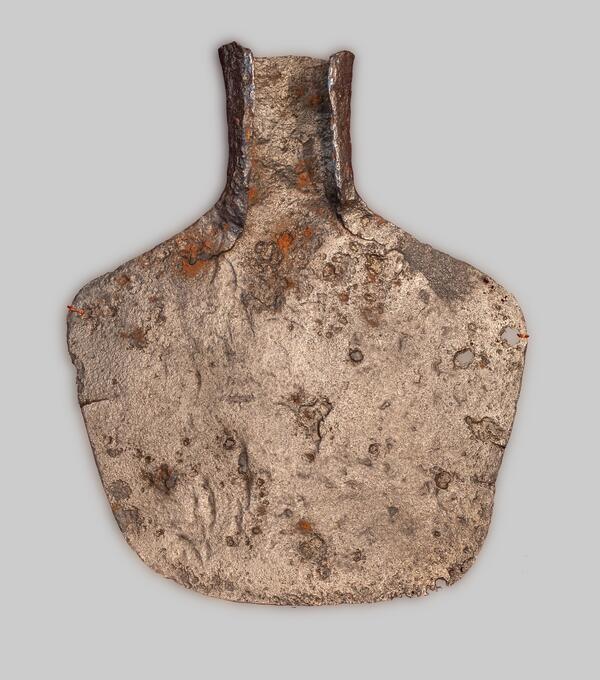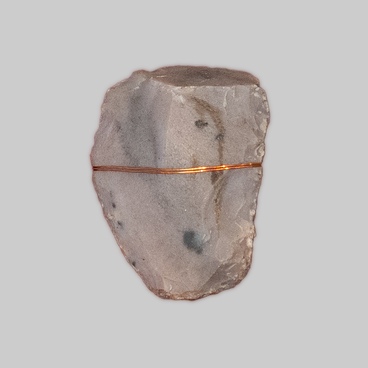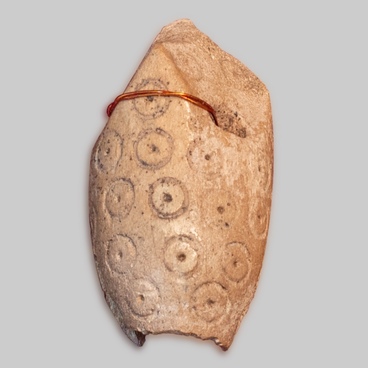The museum collection contains an abyl – a small round-point spade-shaped iron hoe, set on an angle handle. Abyl was used for manual tilling. It was operated the same way as a pickaxe.
A hoe is a hand farming tool. Other names for it are dibber, mattock, digger, ‘sapa’ (from French ‘sape’, in the South of Russia), аnd also, ketmen (grab hoe), in Central Asia. It consists of a wooden handle and a metal useful area set transversely to it. The useful area can be wide or narrow, flat or cambered, or spade-shaped. The blade can also be flat or convex.
A light hoe is used for tillage or weeding. A heavier grab hoe is also used for digging, instead of a spade. And potent hoes called pickaxe or grub axe are used for digging heavy ground and for rock mining. Specific feature of an abyl is a bent handle, and a wide spade-shaped useful area.
Kuznetsk tartars who lived in Kuznetsk region were not only engaged in hunting and crafts. They raised cattle, and vegetable farming was also popular. They grew switch grass and barley, though in modest quantities. It was possible to till a small plot of land using an abyl.
The abyl used for tillage was inherited via female lineage and was an indispensable item of girls’ dowry. The museum artefact discovered in Kuznetsk ostrog was another confirmation of marriages between the Russian and indigenous population.
As all iron and steel items of Kuznetsk tartars, abyl was made of refined iron – a semi-fabricated product of bloomer process. The bloom was heated in the furnace many times over, and forged on a stone anvil to finally shape it. Iron ores of Mountain Shoriya contain natural impurities (manganese, titanium, vanadium) in the amounts sufficient for obtaining high quality alloy metal.
Kuznetsk tartars mined ore “from the mountain surface, layer by layer”, then rafted it to the place of smelting. After ore roasting and initial smelting, they obtained blooms that were further processed into ready items or were given to the state as a tribute. Later, Kuznetsk tartars adopted the Russian blacksmith’s methods and equipment.
A hoe is a hand farming tool. Other names for it are dibber, mattock, digger, ‘sapa’ (from French ‘sape’, in the South of Russia), аnd also, ketmen (grab hoe), in Central Asia. It consists of a wooden handle and a metal useful area set transversely to it. The useful area can be wide or narrow, flat or cambered, or spade-shaped. The blade can also be flat or convex.
A light hoe is used for tillage or weeding. A heavier grab hoe is also used for digging, instead of a spade. And potent hoes called pickaxe or grub axe are used for digging heavy ground and for rock mining. Specific feature of an abyl is a bent handle, and a wide spade-shaped useful area.
Kuznetsk tartars who lived in Kuznetsk region were not only engaged in hunting and crafts. They raised cattle, and vegetable farming was also popular. They grew switch grass and barley, though in modest quantities. It was possible to till a small plot of land using an abyl.
The abyl used for tillage was inherited via female lineage and was an indispensable item of girls’ dowry. The museum artefact discovered in Kuznetsk ostrog was another confirmation of marriages between the Russian and indigenous population.
As all iron and steel items of Kuznetsk tartars, abyl was made of refined iron – a semi-fabricated product of bloomer process. The bloom was heated in the furnace many times over, and forged on a stone anvil to finally shape it. Iron ores of Mountain Shoriya contain natural impurities (manganese, titanium, vanadium) in the amounts sufficient for obtaining high quality alloy metal.
Kuznetsk tartars mined ore “from the mountain surface, layer by layer”, then rafted it to the place of smelting. After ore roasting and initial smelting, they obtained blooms that were further processed into ready items or were given to the state as a tribute. Later, Kuznetsk tartars adopted the Russian blacksmith’s methods and equipment.



